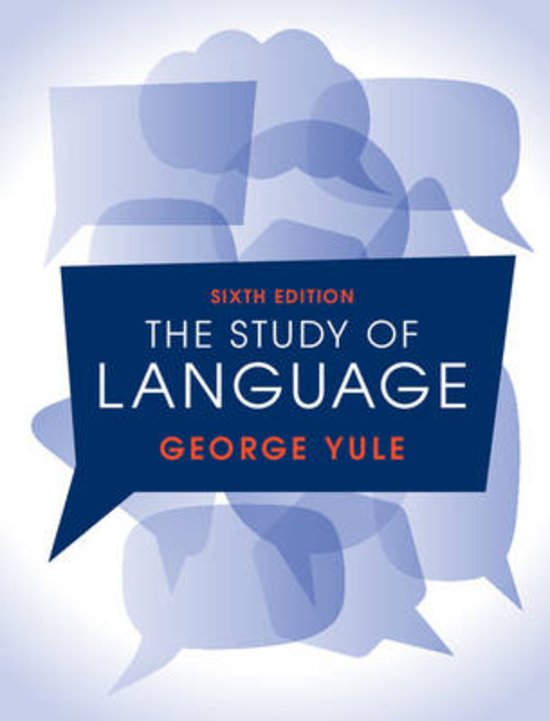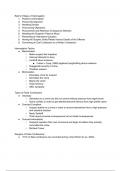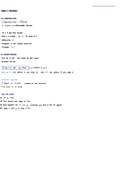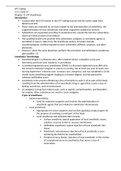Exam preparation questions
1. (Chapter one)
a. Explain what the ...* source is regarding the origin of language (using no more than 25
words)(2 pts).
Divine source: A divine source provided humans with language
Natural sound: You acquire language between the sound and the thing making the sound. For
instance, the bow-wow theory or the pooh-pooh theory.
Social interaction: When people started communicatng, it was for survival.
Physical adaption: We are more likely to produce speech because of our physical features. For
instance, our teeth are upright and smaller which enhances producing sounds.
Tool-making: Our primal functons like bitng and sucking have developed into speech.
Genetic: There might be some language gene which gives us the capacity to produce language.
b. Menton one feature of language it is able to explain ( pt)
Divine: This theory explains why we have the ability to produce sound. All the other theories don’t
really explain this.
Natural sound: It does explain how we use words that make a sound (like some birds)
Social interaction: Humans are known to be social creatures, without communicaton there will be
no survival so they had to produce some kind of sound.
Physical adaption: It explains that we have a capacity for speech, more than other creatures.
Tool-making: It explains that our tool-making ability and our ability to produce language are next to
each other, which explains how we put multple words together.
Genetic: Deaf children can stll use sign language even without being exposed to other language.
OR**
b. Menton one feature it cannot account for ( pt)
Divine: There were children who were found and didn’t speak a language because they had no input.
If language was given to us by a divine source, why does it keep changing? Wouldn’t we have been
given some ‘complete’ version?
Natural sound: It doesn’t account for how we started forming words that do not make sound – like
abstract things or feelings.
Social interaction: Other creatures that communicate did not and never will develop in the way we
did, their language is more primal.
Physical adaption: How we actually started talking – it just shows us that we are able to but not how
we learn how to use those features.
Tool-making: It doesn’t explain how we actually make sentences and how we use complex language.
Genetic: It hasn’t been biologically proven.
* any of these terms may appear on the test here: divine, natural sound, social interaction, physical
adaptation, tool-making, genetic
** this means either b. queston may appear on the test, which will have been selected by the
teacher (so it does not mean you get to choose which queston you answer)
2. Chapter two
a. Defne ...* as a distnct property of human language (using no more than 25 words). (2 pts)
Reflexivity: A special property of language that allows language to be used to think and talk about
language itself.
,Displacement: A property of human language that allows users to talk about things and events not
present in the immediate environment like tme and place.
Arbitrariness: A property of language describing the fact that there is no natural connecton between
a linguistc form and its meaning
Productivity: A property of language that allows users to create new expressions including the ability
to create new words and to combine words.
Duality: A property of language whereby linguistc forms have two simultaneous levels of sound
producton and meaning
Cultural transmission: The process whereby knowledge of a language is passed from one generaton
to the next.
b. Give an example of animal communicaton that supports the idea that …** is exclusively human.
( pt)
Reflexivity: A cat doesn’t meow about how it’s meowing – A cricket doesn’t tell another cricket how
it is supposed to chirp.
Displacement A bunny couldn’t tell another bunny that the food is behind the door – A dog can’t
express something like GRRR last night
Arbitrariness: Elephants use a loud trumpet sound to warn others. - Male birds using a pleasant
melody to seduce a female.
Productivity: Vervet monkeys have exactly 36 diferent vocal calls. – Cicadas have only four signals to
choose from
Duality: A dog can say woof but it cannot produce other words/messages from the same elements. –
When sheep bleat their message can’t be broken up into smaller units.
Cultural transmission: A monkey calls out instnctvely, even in isolaton. – A cat will always meow
the same way, no mater where it grows up.
OR***
b. Give an example of animal communicaton that goes against the idea that …** is exclusively
human ( pt)
Reflexivity: No example
Displacement: Honey bees can direct other bees to a food source they just came back from.
Arbitrariness: Apes can use a blue triangle to refer to an apple.
Productivity: An ape once signed water bird to refer to a swan.
Duality: No example
Cultural transmission: Some songbirds fail to learn a song if they don’t hear it from their parents.
3:
3. Chapter 4 (British)
Write a representation of the number of consonant sounds (C) and vowel sounds (V)
for each of the following syllables. (6 pts)
a. strong CCCVC
b. text CVCCC
c. psyched CVCC
, d. phone CVC
e. mouthed CVCC
f. shrink CCVCC
Other examples:
1. dare – CV
2. clear – CCV
3. straw – CCCV
4. cloths – CCVCC
5. tasks – CVCCC
6. fame – CVC
7. out – VC
8. cash – CVC
9. sprayed – CCCVC
10. foe – CV
11. screw – CCCV
12. ash – VC
13. aimed – VCC
14. awe – V
15. queen – CCVC
16. folks – CVCC
17. strike – CCCVC
18. floor – CCV
19. cow – CV
20. crests - CCVCCC
21. snare – CCV
1. (Chapter one)
a. Explain what the ...* source is regarding the origin of language (using no more than 25
words)(2 pts).
Divine source: A divine source provided humans with language
Natural sound: You acquire language between the sound and the thing making the sound. For
instance, the bow-wow theory or the pooh-pooh theory.
Social interaction: When people started communicatng, it was for survival.
Physical adaption: We are more likely to produce speech because of our physical features. For
instance, our teeth are upright and smaller which enhances producing sounds.
Tool-making: Our primal functons like bitng and sucking have developed into speech.
Genetic: There might be some language gene which gives us the capacity to produce language.
b. Menton one feature of language it is able to explain ( pt)
Divine: This theory explains why we have the ability to produce sound. All the other theories don’t
really explain this.
Natural sound: It does explain how we use words that make a sound (like some birds)
Social interaction: Humans are known to be social creatures, without communicaton there will be
no survival so they had to produce some kind of sound.
Physical adaption: It explains that we have a capacity for speech, more than other creatures.
Tool-making: It explains that our tool-making ability and our ability to produce language are next to
each other, which explains how we put multple words together.
Genetic: Deaf children can stll use sign language even without being exposed to other language.
OR**
b. Menton one feature it cannot account for ( pt)
Divine: There were children who were found and didn’t speak a language because they had no input.
If language was given to us by a divine source, why does it keep changing? Wouldn’t we have been
given some ‘complete’ version?
Natural sound: It doesn’t account for how we started forming words that do not make sound – like
abstract things or feelings.
Social interaction: Other creatures that communicate did not and never will develop in the way we
did, their language is more primal.
Physical adaption: How we actually started talking – it just shows us that we are able to but not how
we learn how to use those features.
Tool-making: It doesn’t explain how we actually make sentences and how we use complex language.
Genetic: It hasn’t been biologically proven.
* any of these terms may appear on the test here: divine, natural sound, social interaction, physical
adaptation, tool-making, genetic
** this means either b. queston may appear on the test, which will have been selected by the
teacher (so it does not mean you get to choose which queston you answer)
2. Chapter two
a. Defne ...* as a distnct property of human language (using no more than 25 words). (2 pts)
Reflexivity: A special property of language that allows language to be used to think and talk about
language itself.
,Displacement: A property of human language that allows users to talk about things and events not
present in the immediate environment like tme and place.
Arbitrariness: A property of language describing the fact that there is no natural connecton between
a linguistc form and its meaning
Productivity: A property of language that allows users to create new expressions including the ability
to create new words and to combine words.
Duality: A property of language whereby linguistc forms have two simultaneous levels of sound
producton and meaning
Cultural transmission: The process whereby knowledge of a language is passed from one generaton
to the next.
b. Give an example of animal communicaton that supports the idea that …** is exclusively human.
( pt)
Reflexivity: A cat doesn’t meow about how it’s meowing – A cricket doesn’t tell another cricket how
it is supposed to chirp.
Displacement A bunny couldn’t tell another bunny that the food is behind the door – A dog can’t
express something like GRRR last night
Arbitrariness: Elephants use a loud trumpet sound to warn others. - Male birds using a pleasant
melody to seduce a female.
Productivity: Vervet monkeys have exactly 36 diferent vocal calls. – Cicadas have only four signals to
choose from
Duality: A dog can say woof but it cannot produce other words/messages from the same elements. –
When sheep bleat their message can’t be broken up into smaller units.
Cultural transmission: A monkey calls out instnctvely, even in isolaton. – A cat will always meow
the same way, no mater where it grows up.
OR***
b. Give an example of animal communicaton that goes against the idea that …** is exclusively
human ( pt)
Reflexivity: No example
Displacement: Honey bees can direct other bees to a food source they just came back from.
Arbitrariness: Apes can use a blue triangle to refer to an apple.
Productivity: An ape once signed water bird to refer to a swan.
Duality: No example
Cultural transmission: Some songbirds fail to learn a song if they don’t hear it from their parents.
3:
3. Chapter 4 (British)
Write a representation of the number of consonant sounds (C) and vowel sounds (V)
for each of the following syllables. (6 pts)
a. strong CCCVC
b. text CVCCC
c. psyched CVCC
, d. phone CVC
e. mouthed CVCC
f. shrink CCVCC
Other examples:
1. dare – CV
2. clear – CCV
3. straw – CCCV
4. cloths – CCVCC
5. tasks – CVCCC
6. fame – CVC
7. out – VC
8. cash – CVC
9. sprayed – CCCVC
10. foe – CV
11. screw – CCCV
12. ash – VC
13. aimed – VCC
14. awe – V
15. queen – CCVC
16. folks – CVCC
17. strike – CCCVC
18. floor – CCV
19. cow – CV
20. crests - CCVCCC
21. snare – CCV






